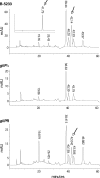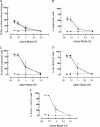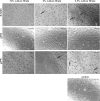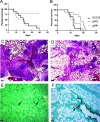Gliotoxin is a virulence factor of Aspergillus fumigatus: gliP deletion attenuates virulence in mice immunosuppressed with hydrocortisone
- PMID: 17601876
- PMCID: PMC2043361
- DOI: 10.1128/EC.00141-07
Gliotoxin is a virulence factor of Aspergillus fumigatus: gliP deletion attenuates virulence in mice immunosuppressed with hydrocortisone
Abstract
Gliotoxin is an immunosuppressive mycotoxin long suspected to be a potential virulence factor of Aspergillus fumigatus. Recent studies using mutants lacking gliotoxin production, however, suggested that the mycotoxin is not important for pathogenesis of A. fumigatus in neutropenic mice resulting from treatment with cyclophosphomide and hydrocortisone. In this study, we report on the pathobiological role of gliotoxin in two different mouse strains, 129/Sv and BALB/c, that were immunosuppressed by hydrocortisone alone to avoid neutropenia. These strains of mice were infected using the isogenic set of a wild type strain (B-5233) and its mutant strain (gliPDelta) and the the glip reconstituted strain (gliP(R)). The gliP gene encodes a nonribosomal peptide synthase that catalyzes the first step in gliotoxin biosynthesis. The gliPDelta strain was significantly less virulent than strain B-5233 or gliP(R) in both mouse models. In vitro assays with culture filtrates (CFs) of B-5233, gliPDelta, and gliP(R) strains showed the following: (i) deletion of gliP abrogated gliotoxin production, as determined by high-performance liquid chromatography analysis; (ii) unlike the CFs from strains B-5233 and gliP(R), gliPDelta CFs failed to induce proapoptotic processes in EL4 thymoma cells, as tested by Bak conformational change, mitochondrial-membrane potential disruption, superoxide production, caspase 3 activation, and phosphatidylserine translocation. Furthermore, superoxide production in human neutrophils was strongly inhibited by CFs from strain B-5233 and the gliP(R) strain, but not the gliPDelta strain. Our study confirms that gliotoxin is an important virulence determinant of A. fumigatus and that the type of immunosuppression regimen used is important to reveal the pathogenic potential of gliotoxin.
Figures





Similar articles
-
Deletion of the gliP gene of Aspergillus fumigatus results in loss of gliotoxin production but has no effect on virulence of the fungus in a low-dose mouse infection model.Mol Microbiol. 2006 Oct;62(1):292-302. doi: 10.1111/j.1365-2958.2006.05373.x. Epub 2006 Aug 31. Mol Microbiol. 2006. PMID: 16956378
-
Gliotoxin production in Aspergillus fumigatus contributes to host-specific differences in virulence.J Infect Dis. 2008 Feb 1;197(3):479-86. doi: 10.1086/525044. J Infect Dis. 2008. PMID: 18199036
-
Role of laeA in the Regulation of alb1, gliP, Conidial Morphology, and Virulence in Aspergillus fumigatus.Eukaryot Cell. 2007 Sep;6(9):1552-61. doi: 10.1128/EC.00140-07. Epub 2007 Jul 13. Eukaryot Cell. 2007. PMID: 17630330 Free PMC article.
-
What do we know about the role of gliotoxin in the pathobiology of Aspergillus fumigatus?Med Mycol. 2009;47 Suppl 1(Suppl 1):S97-103. doi: 10.1080/13693780802056012. Epub 2008 May 2. Med Mycol. 2009. PMID: 18608908 Free PMC article. Review.
-
Biosynthesis and function of gliotoxin in Aspergillus fumigatus.Appl Microbiol Biotechnol. 2012 Jan;93(2):467-72. doi: 10.1007/s00253-011-3689-1. Epub 2011 Nov 18. Appl Microbiol Biotechnol. 2012. PMID: 22094977 Review.
Cited by
-
Identification and characterization of an Aspergillus fumigatus "supermater" pair.mBio. 2011 Nov 22;2(6):e00234-11. doi: 10.1128/mBio.00234-11. Print 2011. mBio. 2011. PMID: 22108383 Free PMC article.
-
Direct Visualization of Fungal Burden in Filamentous Fungus-Infected Silkworms.J Fungi (Basel). 2021 Feb 13;7(2):136. doi: 10.3390/jof7020136. J Fungi (Basel). 2021. PMID: 33668495 Free PMC article.
-
Aspergillosis and stem cell transplantation: An overview of experimental pathogenesis studies.Virulence. 2016 Nov 16;7(8):950-966. doi: 10.1080/21505594.2016.1231278. Epub 2016 Sep 29. Virulence. 2016. PMID: 27687755 Free PMC article. Review.
-
Fungal antioxidant pathways promote survival against neutrophils during infection.J Clin Invest. 2012 Jul;122(7):2482-98. doi: 10.1172/JCI63239. Epub 2012 Jun 18. J Clin Invest. 2012. PMID: 22706306 Free PMC article.
-
Aspergillus Endophthalmitis: Epidemiology, Pathobiology, and Current Treatments.J Fungi (Basel). 2022 Jun 22;8(7):656. doi: 10.3390/jof8070656. J Fungi (Basel). 2022. PMID: 35887412 Free PMC article. Review.
References
-
- Belkacemi, L., R. C. Barton, V. Hopwood, and E. G. Evans. 1999. Determination of optimum growth conditions for gliotoxin production by Aspergillus fumigatus and development of a novel method for gliotoxin detection. Med. Mycol. 37:227-233. - PubMed
-
- Cramer, R. A., Jr., M. P. Gamcsik, R. M. Brooking, L. K. Najvar, W. R. Kirkpatrick, T. F. Patterson, C. J. Balibar, J. R. Graybill, J. R. Perfect, S. N. Abraham, and W. J. Steinbach. 2006. Disruption of a nonribosomal peptide synthetase in Aspergillus fumigatus eliminates gliotoxin production. Eukaryot. Cell. 5:972-980. - PMC - PubMed
Publication types
MeSH terms
Substances
Grants and funding
LinkOut - more resources
Full Text Sources
Other Literature Sources
Medical
Research Materials

